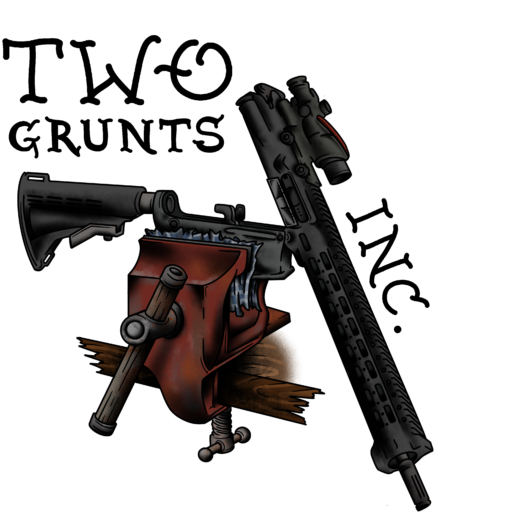Your cart is currently empty!
AR-15 Rifling/Twists
This guide seeks to cover AR-15 rifling/twists. In the context of firearms, rifling refers to the process of milling helical grooves into the internal (bore) surface of a gun’s barrel in order to apply torque.
This thereby imparts a spin to a projectile during shooting in order to stabilize the projectile longitudinally by conservation of angular momentum, improving its aerodynamic stability and accuracy over smoothbore designs.
Understanding AR-15 Rifling/Twist Rates
The term “twist” or “rifling” refers to the number of rotations a bullet will complete before exiting the barrel of a rifle. A higher spin rate, or tighter spiral, is required for accurate flight of the round to its target.
The bullet’s length and weight (measured in grains) also play a role in determining the appropriate twist rate. When choosing a twist rate, it is important to consider the bullet’s length and weight. Longer, heavier bullets require more spin before exiting the barrel to stabilize and remain accurate, while shorter, lighter bullets require less spin.
Too much spin can result in inaccurate shots, just as too little can. The first number in a barrel’s rifling or twist “1” represents one full rotation of the bullet, and the second number “7/8/9” represents the number of inches of travel within the barrel for the bullet to complete one rotation.
For example, a 1:7 twist will result in one full rotation of the bullet within the barrel per 7 inches of travel.
5.56 Twist Rate Progressions
In the early variations of the AR-15, a 1:14 twist rate was used which was much too slow for the 5.56 rounds commonly used by the US military, resulting in the “tumbling” of the round.
The next generation M16A1, commonly used in the 1960s, adopted a faster 1:12 twist rate which still resulted in slower stabilization and a less accurate rifle.
The US Military finally landed on the 1:7 twist rate for its M16A2 rifles upon adoption of the modern M855 62 grain 5.56 round. They have kept this rate through today and through the progressions of the M16 rifle, such as the M16A4, M4A1, and Mk12.
AR-15 Rifling/Twist (5.56 NATO, .223 Rem)
Most Common Modern Twist Rates
The most common twist rate among modern AR-15 barrels is typically 1:7, while 1:8 and 1:9 are the next two most common. The 1:7 twist is the standard among US military rifles and is considered the “mil-spec” of rifling twists for 5.56 barrels/AR-15s.
The 1:8 twist is becoming increasingly popular, especially among higher-end ARs and those who build their own. It is considered the middle ground and a happy medium.
The 1:9 twist, the slowest of the three discussed, is best suited for shorter, lighter bullets.
AR-15 Rifling/Twist
AR-15 Twists Rates 1:7 vs 1:8 vs 1:9
The 1:7 twist is what the US military adopted and has kept as the standard. However, it is not necessarily the best or most ideal twist rate. It is suitable for accuracy with the lighter M193 55-grain round and improves and performs well with the M855 62-grain.
The 1:8 twist is becoming increasingly popular among newly manufactured ARs and especially popular with those who build their own ARs. It is considered versatile in shooting both lighter and heavier rounds and offers improved accuracy when firing the most common 62-grain, M855, or “green tip” NATO rounds.
The 1:9 twist is best suited for those who build or require a varmint gun and will be shooting lighter and shorter rounds.
AR-15 RIfling/Twists
Conclusion
Choosing the right twist rate for your AR-15 can have a significant impact on its accuracy and performance. The standard twist rate among US military rifles is 1:7, but the 1:8 twist is becoming increasingly popular for its versatility in shooting both lighter and heavier rounds.
The 1:9 twist is best suited for shorter and lighter bullets. It’s essential to take into account the bullet’s length and weight when selecting a twist rate, as well as your specific needs and intended use for the rifle. It’s important to note that while the US military has settled on the 1:7 twist rate, this doesn’t necessarily make it the best option for everyone.
Factors such as personal preference and the types of rounds you plan on using can also play a role in determining the most suitable twist rate for you. To find the right fit, it’s worth considering testing different twist rates with different ammo.
Keep in mind that the faster the twist rate, the tighter the spiral of the bullet’s flight path, which theoretically results in a more accurate shot, but too much spin can lead to inaccurate shots just as too little can. In summary, understanding twist rates and how they affect the accuracy and performance of your AR-15 is crucial in finding the right fit for your needs.
Ultimately, testing different twist rates with different types of ammo can help you determine the best fit for you.
Be sure to read our other guides here!
